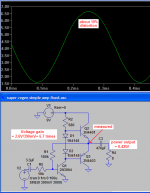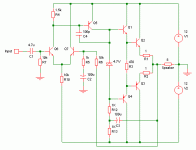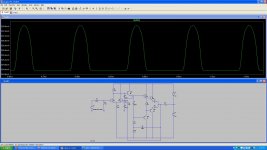Please supply circuit. LTP (long tail pair) operating points are usually determined by current source or resistor to supply rail going to the emitters, then a resistor to ground or to input circuit on one base, and a circuit from feedback to the other base, so that both bases are about the same voltage, and the emitter current is supplied. (I prefer the term operating point rather than bias - YMMV)
Hello,
I am trying to make an amplifier ( using transistor) of 5watt ( near by this) for this a long tail pair is required in many circuits...
I have seen many link but i don't understand its biasing.
Please tell how to make it.??
Thanks
Transistors
what about value of resistance??If you like cheapnis just use resistors.
and if i want to make hi-fi (Good) then??
Find and inspect/analyze the old Accuphase P-300 circuit. Just resistors for current sources can easily be hi-fi. At some point it becomes a matter of taste. You'd have to build or listen to a lot of circuits to really know what you're after.  Generally, more transistors is not always the solution.
Generally, more transistors is not always the solution.
Far as ballpark figuring out how much collector current you have in an LTP, just figure the emitters are one junction drop beyond the bases, and do V/R on the emitter resistors. Divide the answer in two to find per transistor operating point. To decide how much current you Want requires a lot of mental fiddling with facts about how that changes circuit response alongside the available graphs in the datasheets, or a bunch of messing around in spice. Around 1mA is often pretty close for input stage transistors.
Far as ballpark figuring out how much collector current you have in an LTP, just figure the emitters are one junction drop beyond the bases, and do V/R on the emitter resistors. Divide the answer in two to find per transistor operating point. To decide how much current you Want requires a lot of mental fiddling with facts about how that changes circuit response alongside the available graphs in the datasheets, or a bunch of messing around in spice. Around 1mA is often pretty close for input stage transistors.
LT spice will not help teach him how a transistor varies the current as the Vbe is modulated.
There are many tutorials on transistor operation and simple transistor circuits that explain what is going on and why LTPs have some advantages in certain situations. LT spice can never teach these rudiments.
You have to understand the operation to allow you to ask LT spice the correct questions to examine the predictions that LT spice will spew forth. Without the correct questions one cannot make progress with LT spice.
Why do you think a Member posted?
Outcome.
Forget LT spice.
There are many tutorials on transistor operation and simple transistor circuits that explain what is going on and why LTPs have some advantages in certain situations. LT spice can never teach these rudiments.
You have to understand the operation to allow you to ask LT spice the correct questions to examine the predictions that LT spice will spew forth. Without the correct questions one cannot make progress with LT spice.
Why do you think a Member posted?
Find and inspect/analyze the old Accuphase P-300 circuit.
Outcome.
Forget LT spice.
Here is a simple 5 watt amplifier. R6 and R7 are a long-tailed pair. R10 provides about 1mA of current to their emitters.
If the bases of Q6 and Q7 are at the same voltage, then they will each conduct half that current. The current through Q6 is just enough to turn on Q5.
If the base of Q6 is at a higher voltage than the base of Q7, then Q6 will conduct more current and Q7 will conduct less.
If the base of Q7 is at a higher voltage than the base of Q6, then Q7 will conduct more current and Q6 will conduct less.
In this circuit, the input voltage is applied to the base of Q6 and a fraction (1/11) of the output voltage is applied to the base of Q7, so the long tailed pair is used to compare the input voltage to the output voltage.
If the output voltage is too low, then the voltage on the base of Q7 will also be too low. This causes more current to flow through Q6 which causes Q5 to turn on harder, pulling the output up towards the correct voltage.
When the output voltage is too high, the voltage on the base of Q7 will be too high and less current will flow through Q6 and Q5, causing the output voltage to go down towards the correct voltage.
Hope that helps.
If the bases of Q6 and Q7 are at the same voltage, then they will each conduct half that current. The current through Q6 is just enough to turn on Q5.
If the base of Q6 is at a higher voltage than the base of Q7, then Q6 will conduct more current and Q7 will conduct less.
If the base of Q7 is at a higher voltage than the base of Q6, then Q7 will conduct more current and Q6 will conduct less.
In this circuit, the input voltage is applied to the base of Q6 and a fraction (1/11) of the output voltage is applied to the base of Q7, so the long tailed pair is used to compare the input voltage to the output voltage.
If the output voltage is too low, then the voltage on the base of Q7 will also be too low. This causes more current to flow through Q6 which causes Q5 to turn on harder, pulling the output up towards the correct voltage.
When the output voltage is too high, the voltage on the base of Q7 will be too high and less current will flow through Q6 and Q5, causing the output voltage to go down towards the correct voltage.
Hope that helps.
Attachments
RRITESH, the beauty of spice (and the beautifully free graphical interface of LTspice), is that you can easily change semiconductor types and part values and see what happens to circuit response.
If you wonder about a change, try it in software and see what it does! You wont even have to buy and blow up any parts finding out.
If you wonder about a change, try it in software and see what it does! You wont even have to buy and blow up any parts finding out.
thanks for taking the time to explain.
Thanks for showing that LT spice cannot provide that type of tutorial.
RR & 6B,
wake up
Don't mind, thank for understanding newbie...
also, the old Accuphase circuit is not really all that complex. The lower bias impedance at the emitter node of the differentials (caused by absence of active current source) is probably one reason why they used two cascaded voltage amplifiers. You can plug in just a single amplifier stage and play around with it to see how it works. If it doesn't work at first, play some more.
- Status
- This old topic is closed. If you want to reopen this topic, contact a moderator using the "Report Post" button.
- Home
- Amplifiers
- Solid State
- How to bias Long tail pair....??


